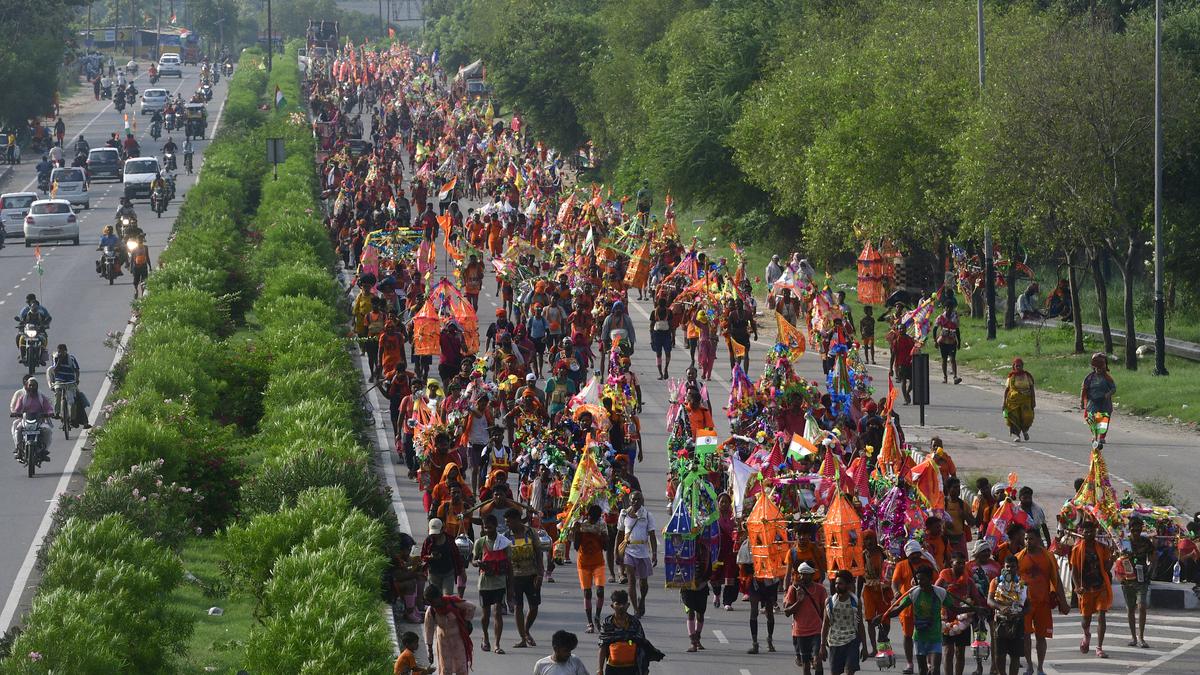
Delhi traffic police’s elaborate plan ahead for Kanwar Yatra
The Hindu
In view of the Kanwar yatra devotees, whose movement will be expected from adjoining States to Gangotri Dham and Haridwar through the national capital, Delhi traffic police has made elaborate traffic arrangements and has informed that traffic congestion will be expected from certain areas.
In view of the Kanwar yatra devotees, whose movement will be expected from adjoining States to Gangotri Dham and Haridwar through the national capital, Delhi traffic police has made elaborate traffic arrangements and has informed that traffic congestion will be expected from certain areas.
Every year, during the Hindu lunar month of Shravan, devotees travel on–foot from GauMukh, Gangotri Dham and Haridwar to offer holy Ganga water at Shiva Temples on Shravan Shivratri.
Expected to begin on July 4, it will culminate on July 15. Delhi traffic police said, many Kanwariyas reach Delhi and some of them go to Haryana and Rajasthan through Delhi borders. This year the expected number is about 15-20 lakhs.
“We’ve made elaborate arrangements to segregate the movement of Kanwarias and other road users and to minimize inconvenience to the public and devotees. The devotees and road users are advised to follow the traffic rules and obey the directions of policemen on duty,” police said.
During this period of the Kanwarias movement, traffic violations will be checked by on-the-spot prosecution and by photography and videography of violations which will be followed by prosecution.
Police has planned diversion plans for heavy transport vehicles too. HTVs except city buses will not be allowed on GT Road towards Shahdara and Wazirabad Road.
Heavy commercial transport vehicles, except city buses, coming from GT Karnal Road at Outer Ring Road will be diverted straight towards NH-24 and will not be allowed to move on Wazirabad Road and GT Road towards Shahdara.

“Writing, in general, is a very solitary process,” says Yauvanika Chopra, Associate Director at The New India Foundation (NIF), which, earlier this year, announced the 12th edition of its NIF Book Fellowships for research and scholarship about Indian history after Independence. While authors, in general, are built for it, it can still get very lonely, says Chopra, pointing out that the fellowship’s community support is as valuable as the monetary benefits it offers. “There is a solid community of NIF fellows, trustees, language experts, jury members, all of whom are incredibly competent,” she says. “They really help make authors feel supported from manuscript to publication, so you never feel like you’re struggling through isolation.”

Several principals of government and private schools in Delhi on Tuesday said the Directorate of Education (DoE) circular from a day earlier, directing schools to conduct classes in ‘hybrid’ mode, had caused confusion regarding day-to-day operations as they did not know how many students would return to school from Wednesday and how would teachers instruct in two modes — online and in person — at once. The DoE circular on Monday had also stated that the option to “exercise online mode of education, wherever available, shall vest with the students and their guardians”. Several schoolteachers also expressed confusion regarding the DoE order. A government schoolteacher said he was unsure of how to cope with the resumption of physical classes, given that the order directing government offices to ensure that 50% of the employees work from home is still in place. On Monday, the Commission for Air Quality Management in the National Capital Region and Adjoining Areas (CAQM) had, on the orders of the Supreme Court, directed schools in Delhi-NCR to shift classes to the hybrid mode, following which the DoE had issued the circular. The court had urged the Centre’s pollution watchdog to consider restarting physical classes due to many students missing out on the mid-day meals and lacking the necessary means to attend classes online. The CAQM had, on November 20, asked schools in Delhi-NCR to shift to the online mode of teaching.









